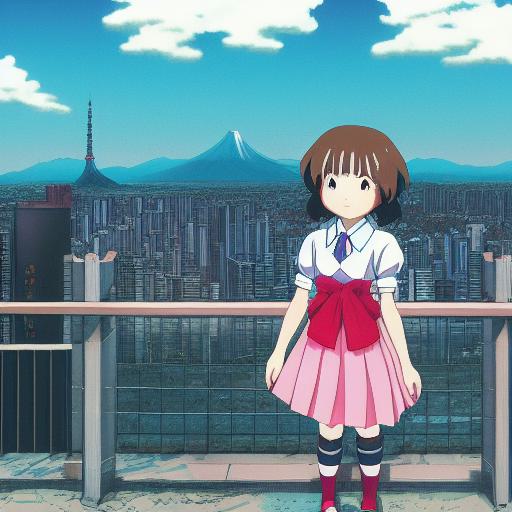How to write this prompt?
Here is a breakdown of the key elements of the prompt and how they influence the image being generated:
- Enchanting anime portrait from Studio Ghibli: This sets the tone and style of the image, indicating that it should be whimsical, fantastical, and anime-inspired.
- School girl in front of the vibrant Tokyo cityscape: This provides the setting for the image, which is a bustling, vibrant cityscape. It also suggests that the image should include a sense of wonder and exploration.
- Analog photo style: This sets the aesthetic of the image, indicating that it should have a vintage or retro look, with filters or effects that mimic the appearance of an old photograph.
- School girl standing on a rooftop: This is the main subject of the image, and provides a sense of scale and perspective by showing the cityscape from a high vantage point.
- Fisheye lens creating a distorted and surreal atmosphere: This affects the composition of the image, adding a distorted and surreal quality to the cityscape that makes it feel dreamlike and otherworldly.
- Crimson school uniform: This adds a touch of drama and intensity to the image, and creates a visual contrast with the bright colors of the cityscape.
- Volumetric fog and overglaze effect: These effects create a hazy, dreamlike atmosphere that further enhances the surreal quality of the image.
- Accent lighting illuminating the school girl’s face: This draws attention to the school girl as the main subject of the image, and highlights her sense of wonder and amazement as she looks out over the cityscape.
By incorporating these specific elements into the prompt, the AI is able to generate an image that captures the whimsical, surreal, and exploratory qualities of a Studio Ghibli anime in a unique and compelling way.
What is the significance of the fisheye lens in photography?
A fisheye lens is a type of wide-angle lens that produces a distinctive, distorted image. It can be used to capture a wide field of view, and creates a sense of depth and perspective in the image. In the context of the prompt, the fisheye lens was used to create a surreal, dreamlike atmosphere in the cityscape.
How to create a vintage or analog photo effect in digital photography?
There are many ways to create a vintage or analog photo effect in digital photography, including using filters or presets in photo editing software, adjusting the brightness, contrast, and saturation levels of the image, and adding texture or grain to the photo. In the context of the prompt, the analog photo style was achieved through the use of filters or effects that mimicked the appearance of an old photograph.
Why is Studio Ghibli famous for its anime films?
Studio Ghibli is a Japanese animation studio that is famous for its anime films because of their distinctive style, engaging stories, and complex characters. Their films often explore themes of nature, adventure, and humanity, and are known for their beautiful animation, intricate sound design, and emotional resonance. In the context of the prompt, the use of Studio Ghibli as a reference point helped to set the tone and style of the image.
Do I need to have technical knowledge or programming skills to use AI art generation prompts?
Using AI art generation prompts can be a relatively straightforward process that does not necessarily require advanced technical knowledge or programming skills. Most AI art generation tools and platforms provide user-friendly interfaces that allow users to input prompts or manipulate parameters in order to generate images. Some platforms may require a basic understanding of image editing software or digital art tools, but the learning curve is usually not steep. However, for more advanced AI art generation techniques, such as developing custom models or working with large datasets, some technical knowledge or programming skills may be necessary.
In summary, the technical expertise required to use AI art generation prompts depends on the specific tool or platform being used and the level of complexity involved in generating the desired art.
Are there any copyright issues with using AI-generated art?
As with any form of digital art, there are potential copyright issues that may arise when using AI-generated art. In general, copyright law protects original creative works that are fixed in a tangible form, such as paintings, photographs, or literary works. AI-generated art that is created using pre-existing images, data, or models may infringe on the copyright of the original creators. Additionally, some AI art generation platforms may have licensing agreements or terms of use that restrict the use or distribution of generated art.
To avoid potential copyright issues when using AI-generated art, it is important to ensure that any pre-existing images, data, or models used in the generation process are properly licensed or in the public domain. Additionally, it may be necessary to obtain permission from the original creators or copyright holders before using or distributing AI-generated art that is based on their work.
In summary, using AI-generated art can raise potential copyright issues, but these can be mitigated by ensuring proper licensing and permissions are obtained before using or distributing the art.
With the aid of design tools such as Visual Paradigm Online, incorporating AI-generated art into your designs has never been easier. Visual Paradigm Online provides a user-friendly interface and a variety of design templates and assets, enabling you to experiment with various styles and layouts until you find the perfect match for your project. In just a few clicks, you can produce stunning and visually appealing graphics that will captivate your audience.


